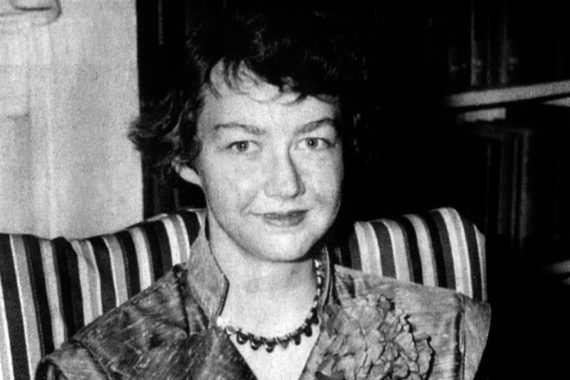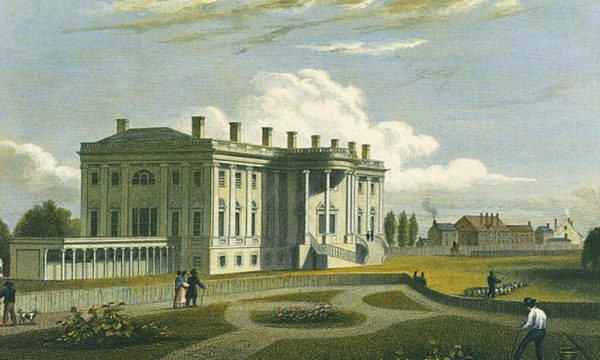The great Georgian writer of the mid-twentieth century Flannery O’Connor famously described herself as a “hillbilly Thomist,” a nod both to her Southern origins and her dedication to the medieval theologian and philosopher Thomas Aquinas. However much yankee intellectuals thumbed their noses at the South, the hillbilly moniker was not a little discordant given the well-educated O’Connor hailed from a bourgeois Savannah family. Yet “Hillbilly Thomism” does nicely capture both the identity and corpus of one of the South’s most gifted writers, whose art — and her understanding of the craft — are perhaps more relevant now than when she wrote.
In Understanding the Hillbilly Thomist: The Philosophical Foundations of Flannery O’Connor’s Narrative Art, Fr. Damian Ference notes that O’Connor’s writing portrayed a modern world “marked by self-centeredness, disregard for mystery, and the subordination of reason.” In a 1947 journal entry, the twenty-two-year-old O’Connor expressed her desire to present a counter to soulless modernity: “I must write down that I am to be an artist. Not in the sense of aesthetic frippery but in the sense of aesthetic craftsmanship…. I want to be the best artist it is possible for me to be, under God.” Influenced by Aquinas, whom she read nightly as a child, O’Connor engaged in what fellow southern writer Walker Percy called “novelizing philosophy.”
Yet O’Connor, though co-existing in a world of literary luminaries, jokingly rejected what she called “interleckchuls.” She flippantly encouraged friend William Sessions that after acquiring his Ph.D. he should “go ignorant for the rest of your life.” She once confessed: “Anything I can’t stand it’s a young writer or intellectual.” The distinction, Ference argues, is between intellectualism — which fosters hubris and condescension toward the hoi polloi — and the intellectual life, meaning the humble desire to intellectually challenge oneself via new learning.
Instead, O’Connor applied a Thomistic understanding of the world, evincing a belief in the trustworthiness of the senses and the power of common-sense. “The Thomist philosophy is nearer than most philosophies to the mind of the man on the street,” wrote G.K. Chesterton in his biography of St. Thomas. Thomism, says French philosopher Etienne Gilson, is “the solid, down-to-earth realism of the classical metaphysics of being.”
Thus, unlike many of her contempoaries, O’Connor abjured art for the sake of self-expression or shock value. Following Aristotle, who taught that “art imitates nature” (rather than ridiculing or undermining it), she explained: “All I mean by art is writing something that is valuable in itself and that works in itself.” Of course, that doesn’t mean that O’Connor’s writing doesn’t often disturb — as any reader of her work knows. But it shocks in the service of reality, not novelty. As she famously asserted: “You have to make your vision apparent by shock — to the hard of hearing you shout, and for the almost-blind you draw large and startling figures.”
That shock was required, O’Connor argued, because of our nation’s rapid de-Christianization. “The moral sense has been bred out of certain sections of the population, like the wings have been bred off certain chickens to produce more white meat on them,” she declared. “This is a generation of wingless chickens, which I suppose is what Nietzsche meant when he said God was dead.” Our rationalist modern world shorn of faith and wonder, paradoxically, is making us less human, both in its Promethean idolization of technology to transform us into gods, and in its boring, predictable materialist vision of the good life.
A diminishing faith in God comes with a commensurate failure to identify real evil, something O’Connor understood not only from her Catholic catechesis and reading of Aquinas, but her experience as a southerner. In response to the question of why there are so many good Southern writers, she quoted Walker Percy’s answer: “Because we lost the War.” She explained: “He [Percy] didn’t mean by that simply that a lost war makes good subject matter. What he was saying was that we have had our Fall. We have gone into the modern world with an inburnt knowledge of human limitations and with a sense of mystery which could not have developed in our first state of innocence — as it has not sufficiently developed in the rest of the country.” In effect, the failure of the Confederacy engendered in southerns a humility and sense of longing.
The tension of that loss also breeds a certain (often macabre) humor, which is ubiquitous across O’Connor’s oeuvre. Her friend Mary Barbara Tate recalled: “She had told us that she considered herself a comic writer. She certainly did enjoy her own wit and cleverness, as did we.” Aquinas wrote that wittiness “pertains to the mean habit of virtue to speak and to listen to what is becoming in jesting.” To cite but one example from O’Connor, consider the short story “Good Country People,” in which the character Manley Pointer offers a joke to Hulga Hopewell:
Then on what seemed an insuck of breath, he whispered, “You ever ate a chicken that was two days old?”
The girl looked at him stonily. He might have just put this question up for consideration at the meeting of a philosophical association. “Yes,” she presently replied as if she had considered it from all angles.
“It must have been mighty small!” he said triumphantly and shook all over with little nervous giggles, getting very red in the face, and subsiding finally into his gaze of complete admiration, while the girl’s expression remained exactly the same.
Perhaps that humor was intensified by an early diagnosis of lupus, the same disease that killed her father. It also likely intensified a moral clarity that enabled her to reject the sensual, morally ambiguous (if not contemptible) life of so many other writers of her era. While staying at an artists’ colony in New York, she declined their libertine bacchanalia, perceptively observing: “This is not sin but Experience.” Her “experience,” in contrast, was a life of quiet, pious contemplation resembling a religious vocation. In a piece for The Atlanta Journal and Constitution Magazine, a journalist visiting O’Connor’s 544-acre farm remarked: “When her morning’s writing is done, she settles into a rocker on the front porch and just looks.”
A down-to-earth anti-intellectual intellectualism; an aesthetic pursuit of art for the sake of truth and beauty; and a virtuous faith surprisingly familiar with evil. These are the qualities that defined Flannery O’Connor’s life, and make her writing so curiously compelling, if also arresting. Aiming to avoid the “large body of pious trash” that defined so much religious literature, she bequeathed to us a corpus as avowedly Christian as it is southern. If “Hillbilly Thomism” can prevent us from becoming cynical, vapid “wingless chickens,” count me a believer.







Thank you for this very fine essay on my favorite author. I believe that not only was Flannery O’Connor called a hillbilly Thomist, but the New York literary elite called her a hillbilly nihilist. She wrote in her letters that she objected to this characterization because she was not in fact a nihilst! Again a wonderful essay, Mr. Chalk.
chicks are two days old? not chickens?
Thank you, Casey Chalk! I’ve recently learned that actor, Ethan Hawke has produced a movie titled “Wildcat” and it’s about Flannery O’Connor. Has anyone viewed it? I tend to stay away from modern-day movies about the South or Southern people until I hear a positive review from a reliable source. Thanks again for the essay!
I haven’t seen the film yet and will wait until it comes out on DVD. Yet there is a rather favorable review of the movie, written by Damian Ference, the author of the book discussed in the above post. Here is the link to that review: https://www.wordonfire.org/articles/capturing-a-misfit-a-review-of-wildcat/.
Ooops … the above was meant as a reply to David LeBeau’s question. Sorry.
Thanks for the reply.